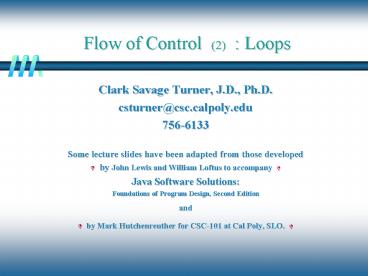Flow of Control (2) : Loops - PowerPoint PPT Presentation
Title:
Flow of Control (2) : Loops
Description:
Some lecture s have been adapted from those developed. by John Lewis and William Loftus to ... Both semi-colons are always required in the for loop header ... – PowerPoint PPT presentation
Number of Views:27
Avg rating:3.0/5.0
Title: Flow of Control (2) : Loops
1
Flow of Control (2) Loops
- Clark Savage Turner, J.D., Ph.D.
- csturner_at_csc.calpoly.edu
- 756-6133
- Some lecture slides have been adapted from those
developed - by John Lewis and William Loftus to accompany
D - Java Software Solutions
- Foundations of Program Design, Second Edition
- and
- by Mark Hutchenreuther for CSC-101 at Cal Poly,
SLO. D
2
Repetition Statements Loops
- Repetition statements allow us to execute a
statement multiple times repetitively - They are often simply referred to as loops
- Like conditional statements, they are controlled
by boolean expressions - Java has three kinds of repetition statements
the while loop, the do loop, and the for loop - The programmer must choose the right kind of loop
for the situation
3
Logic of a while loop
condition evaluated
false
true
4
The while Statement
- The while statement has the following syntax
while ( condition ) statement
The statement is executed repetitively until the
condition becomes false.
5
The while Statement
- If the condition of a while statement is false
initially, the statement is never executed - Thus, the body of a while loop will execute zero
or more times - See Counter.java
- See Average.java
- See WinPercentage.java
6
Logic of a do loop
false
condition evaluated
true
7
The do Statement
- The do statement has the following syntax
do statement while ( condition )
The statement is executed once initially, then
the condition is evaluated
The statement is repetitively executed until the
condition becomes false
8
The do Statement
- A do loop is similar to a while loop, except
thathere the condition is evaluated after the
body of the loop is executed - Therefore the body of a do loop will execute at
least one time - See Counter2.java
- See ReverseNumber.java
9
Comparing the while and do loops
while loop
do loop
condition evaluated
false
true
condition evaluated
false
true
10
Infinite Loops
- The body of a while loop must eventually make the
condition false - If not, it is an infinite loop, which will
execute until the user interrupts the program - These are a very common form of logical error
- You should double check to ensure that your
loops will terminate normally - You should not rely on a break or continue to
exit from a loop when tempted, find another
way out - See Forever.java for an example of this error.
11
Nested Loops
- Similar to nested if statements, loops can be
nested as well - That is, the body of a loop could contain another
loop - Each time through the outer loop, the inner loop
will go through its entire set of iterations - See PalindromeTester.java
12
Logic of a for loop
condition evaluated
false
true
13
The for Statement
- The for statement has the following syntax
for ( initialization condition increment )
statement
14
Comparing the while and for loops
while loop
for loop
condition evaluated
condition evaluated
false
false
true
true
15
The for Statement
- A for loop is equivalent to the following while
loop structure
initialization while ( condition )
statement increment
16
The for Statement
- Like a while loop, the condition of a for
statement is tested prior to executing the loop
body - Therefore, the body of a for loop will execute
zero or more times - It is well suited for executing
- a specific number of times
- that can be determined in advance
- See Counter3.java
- See Multiples.java
- See Stars.java
17
The for Statement
- Each expression in the header of a for loop is
optional - If the initialization is left out, no
initialization is performed - If the condition is left out, it is always
considered to be true, and therefore creates an
infinite loop - If the increment is left out, no increment
operation is performed - Both semi-colons are always required in the for
loop header































